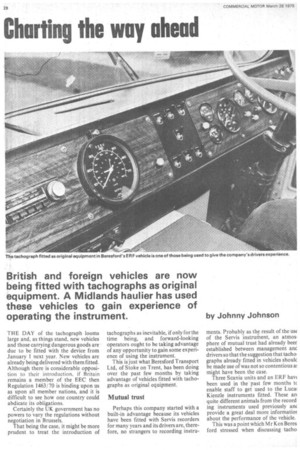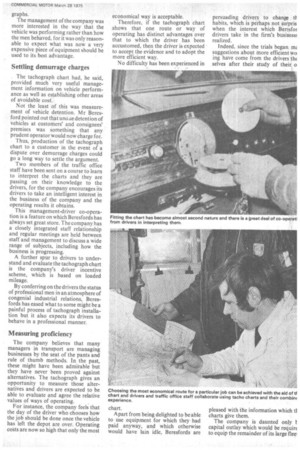Charting the way ahead
Page 30

Page 31

If you've noticed an error in this article please click here to report it so we can fix it.
British and foreign vehicles are now being fitted with tachographs as original equipment. A Midlands haulier has used these vehicles to gain experience of operating the instrument.
by Johnny Johnson
THE DAY of the tachograph looms large and, as things stand, new vehicles and those carrying dangerous goods are due to be fitted with the device from January 1 next year. New vehicles are already being delivered with them fitted. Although there is considerable opposition to their introduction, if Britain remains a member of the EEC then Regulation 1463 / 70 is binding upon us as upon all member nations, and it is difficult to see how one country could abdicate its obligations.
Certainly the UK government has no powers to vary the regulations without negotiation in Brussels.
That being the case, it might be more prudent to treat the introduction of tachographs as inevitable, if only for the time being, and forward-looking operators ought to be taking advantage of any opportunity to gain some experience of using the instrument.
This is just what Beresford Transport Ltd, of Stoke on Trent, has been doing over the past few months by taking advantage of vehicles fitted with tachographs as original equipment.
Mutual trust
Perhaps this company started with a built-in advantage because its vehicles have been fitted with Servis recorders for many years and its drivers are, therefore, no strangers to recording instru ments. Probably as the result of the us( of the Servis instrument, an atmosphere of mutual trust had already beer established between management anc drivers so that the suggestion that tacho. graphs already fitted in vehicles shoulc be made use of was not so contentious a: might have been the case. Three Scania units and an ERF havt been used in the • past few months t( enable staff to get used to the Luca! Kienzle instruments fitted. These arc quite different animals from the record ing instruments used previously am provide a great deal more informatiot about the performance of the vehicle.
This was a point which Mr Ken Beres ford stressed when discussing tacho graphs.
The management of the company was more interested in the way that the vehicle was performing rather than how the men behaved, for it was only reasonable to expect what was now a very expensive piece of equipment should be used to its best advantage.
Settling demurrage charges
The tachograph chart had, he said, provided much very useful management information on vehicle performance as well as establishing other areas of avoidable cost.
Not the least of this was measurement of vehicle detention. Mr Beresford pointed out that uno ae detention of vehicles at customers' and consignees' premises was something that any prudent operator would now charge for.
Thus, production of the tachograph chart to a customer in the event of a dispute over demurrage charges could go a long way to settle the argument.
Two members of the traffic office staff have been sent on a course to learn to interpret the charts and they are passing on their knowledge to the drivers, for the company encourages its drivers to take an intelligent interest in the business of the company and the operating results it obtains.
This management-driver co-operation is a feature on which Beresfords has always set great store. The company has a closely integrated staff relationship and regular meetings are held between staff and management to discuss a wide range of subjects, including how the business is progressing.
A further spur to drivers to understand and evaluate the tachograph chart is the company's driver incentive scheme, which is based on loaded mileage.
By conferring on the drivers the status of professional men in an atmosphere of congenial industrial relations, Beresfords has eased what to some might be a painful process of tachograph installation but it also expects its drivers to behave in a professional manner.
Measuring proficiency
The company believes that many managers in transport are managing businesses by the seat of the pants and rule of thumb methods. In the past, these might have been admirable but they have never been proved against alternatives. The tachograph gives an opportunity to measure those alternatives and drivers are expected to be able to evaluate and agree the relative values of ways of operating.
For instance, the company feels that the day of the driver who chooses how the job should be done once the vehicle has left the depot are over. Operating costs are now so high that only the most economical way is acceptable.
Therefore, if the tachograph chart ,shows that one route or way of operating has distinct advantages over that to which the driver has been accustomed, then the driver is expected to accept the evidence and to adopt the more efficient way.
No difficulty has been experienced in chart.
Apart from being delighted to be able to use equipment for which they had paid anyway, and which otherwise would have lain idle, Beresfords are persuading drivers to change tt habits, which is perhaps not surpris when the interest which Bensfoi drivers take in the firm's business; realized.
Indeed, since the trials began, nu suggestions about more efficient wo ing have come from the drivers the selves after their study of their o pleased with the information which ti charts give them.
The company is daunted only t capital outlay which would be require to equip the remainder of its large fleei




























































































